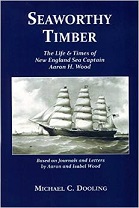Seaworthy Timber: The Life & Times of New England Sea Captain Aaron H. Wood
Michael C. Dooling
 In telling the story of the life of Aaron Wood, from when he starts on board as “boy” to his promotion to able seaman and eventually to captain of his own ships, the author, Michael Dooling, examines the Age of Sail from the great clippers to the Downeasters of Maine at the end of the century. In 1854, Aaron and his friends from Swansea sign aboard Monarch of the Seas with Captain Gardner. On this maiden voyage, the ship tests the new slipway at the Naval Yards in Pensacola and then heads to Europe with cotton, before the ship is recruited to transport supplies, troops and horses to the front lines of the Crimean War in the Black Sea.
In telling the story of the life of Aaron Wood, from when he starts on board as “boy” to his promotion to able seaman and eventually to captain of his own ships, the author, Michael Dooling, examines the Age of Sail from the great clippers to the Downeasters of Maine at the end of the century. In 1854, Aaron and his friends from Swansea sign aboard Monarch of the Seas with Captain Gardner. On this maiden voyage, the ship tests the new slipway at the Naval Yards in Pensacola and then heads to Europe with cotton, before the ship is recruited to transport supplies, troops and horses to the front lines of the Crimean War in the Black Sea.
The book includes Aaron’s first-person accounts of visiting the battlefields at Sevastopol as a spectator and seeing the first-ever use of shell guns and floating iron-sided batteries at Odessa. More surprising than a picnic overlooking the battle, was that the captain’s wife, Mrs. Gardner, was along with them to view the spectacle. These chapters include contemporary maps of the area, a diagram of the floating battery, and photos taken by English war correspondent William Russell. Other figures in the book include paintings and photos of ships, sail plan drawings, clipper sailing cards, portrait photos, and original pages from journals.
Much of the strength of this book is that the portrayals of events and activities are taken from the primary documents and Dooling elaborates on the history that is contemporary to his life such as trade relations, economic trends and the changing importance of shipbuilding in the United States. The author does a wonderful job of bringing in details of people who were part of that history, such as Nathaniel Hawthorne working as the American Consul in Liverpool at the start of the Crimean War. He includes full entries from Aaron’s journal (often only a few sentences each day) and fills in the gaps with information from his friend who signed on at the same time.
After Aaron became captain, he soon married Isabel Pearce in 1864, and his story is continued through her letters as she joins him on the ship. She sailed with him for the next 20 years on four ships; Emerald Isle, St. Mark, Sagamore, and Sovereign of the Seas, Together they survived about twenty-two times around Cape Horn, raising their son Oscar onboard until he was eight years old, and transporting goods until the 1880s, when they finally retired to a vineyard in California.
The only real detriment to the book is the unfortunate choice of a shiny paper for print which makes for a glare on the pages. At times, a chapter will meander a long while before explaining how the history relates to Aaron, but overall the book showcases the author’s dedication to his subject in bringing Captain Wood to life again.
- Carrollton Press, 2014
- 6” x 9”, softcover, 193 pages
- Illustrations, references, notes. $21.95
- ISBN: 9780962742493
Reviewed by R. Laurel Seaborn, Salem, Massachusetts
